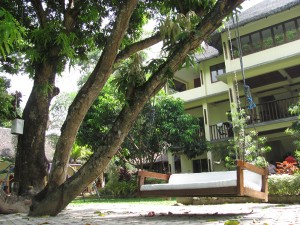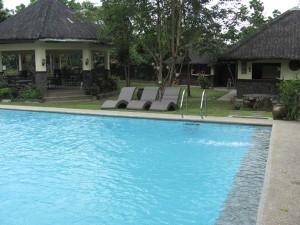By: Karen Boncocan
INQUIRER.net
Lawiswis Kawayan, nestled within a quiet community in Calumpit town in Bulacan where the sound of chirping birds and swaying bamboos and the relaxed feeling one gets after a good massage can bring only bliss. Video by INQUIRER.net’s Cathy Miranda
MANILA, Philippines – Have you ever eagerly packed your bags and headed out of the city for a vacation, expecting peace and quiet while lying on the sand in some far-off paradise only to find it swarming with other vacationers?
Getting away from the strains of work and the hustle and bustle of the metropolis may sound divine but it requires a lot of work to find a place where one can simply relax—when everyone else has the same agenda.
Well, fret not, for there is a resort spa just hours from Metro Manila offering peace and quiet the way you like it.
Lawiswis Kawayan is nestled within a quiet community in Calumpit town in Bulacan where the sound of chirping birds and swaying bamboos and the relaxed feeling one gets after a good massage can bring only bliss.
Built six years ago as a rest house by its owners, Angel and Aldrin Aldaba who have been married for almost 12 years, Lawiswis Kawayan gradually evolved from what Angel described as a parcel of land which was bare save for several mango trees into a mini sort of paradise much enjoyed by their clients.
Named after an old song, the Aldabas first thought of the resort as a romantic place for couples who want to enjoy nature.
Angel said that they wanted guests to feel comfortable and at home. Think: home but better.
“I think that’s what sets us apart from other resorts. We really maintain simplicity of the place—there is no exaggeration. There’s no noise during the day except for the chirping of the birds,” said Angel. She also said that the fragrance from Ylang-Ylang flowers which waft throughout the resort in the afternoon were enough to soothe nerves strained from hour after hour of work in the city.
The resort is situated in Buguion village in Calumpit. But as Angel said, “While you would expect resorts by the highway where it can be easily seen—our place is kind of secluded, like a hideaway. We call it the serene hideaway in the north.”
The couple told INQUIRER.net that it all started when they fenced off the property, passed on to Aldrin by his parents, and built on it a rest house supposedly for their use during breaks and was later on rented out for functions like weddings.
“There were no structures here [before and] we fenced up the place for the family but later on it was rented out as a venue for baptisms, weddings,” she added, pointing out that the idea on adding more rooms, open cabanas, a conference room and swimming pools to the place came from their guests.
“There was even no pool in the beginning,” Angel quipped, saying that guests asked whether they could add a swimming pool, open cabanas, a conference room, and later on a spa.
She said that they started with questions of how they could better enjoy the place and thought “we probably will enjoy lying down by the pool. So we placed cushions in the poolside cabanas.
Flanking the pool are wide open cabanas with plush cushions and rattan chaise lounges—something which the owners called their “pool sala”.
“Guests can just lounge [there] while watching their children play,” Angel explained, adding that they also built a spa for guests who told them that they also wanted massages during their vacation.
But an even greater feat for the Aldaba couple was providing rooms for their guests. They now boast of 19 rooms, each with its own television and air-conditioning unit.
Now you may be asking why a resort only has that many rooms for guests and Angel said that they really did cater more for private groups and families.
Lawiswis Kawayan was made “for those who want it quiet—those who want it intimate for family gatherings. That is out target market. For a minimum of about a hundred people the whole place is automatically made private—we will not accept any more guests. That group can enjoy the whole place to themselves,” Angel stated.
The resort prepares meals for their clients but should guests want to bring in their own food, Angel explains that they will pose no corkage fee for those. “They can even grill food—have a picnic. There’s no corkage fee for food except if they avail of a catering service from outside or bring in alcoholic beverages.”
For those on a company outing, Lawiswis Kaawayan also has team building materials “mostly bamboo inspired like the kadang-kadang where you walk on bamboo stilts,” Angel added.
She said that all these amenities, developed and added in six years’ time, made all the difference as their clients told them how relaxing the resort spa was.
But facing ordeals behind the scenes in order to provide the best experience to guests almost made the Aldabas question whether the decision to open Lawiswis Kawayan had been right.
“Putting everything in one basket, we were worried whether tama ba yung decision naming because we only had little savings at pagpapabakod at pagpapadamo pa lang [mahal na]. We had three children who were still little at the time. Sa aming magasawa, nakakastress ang pagpunta dito,” said Angel.
She said that running the resort “was a lot of work for us, a lot of pressure. Ang daming trials along the way but God told us that he gave us a place we only dreamt of—and we would still complain. We realized that we had been so ungrateful.”
Angel said that what she and Aldrin would sit on the swing under a mango tree at the heart of the resort and open a bottle of wine whenever there were problems or whenever there were no guests.
“My husband and I would open a bottle of wine, kwentuhan na lang. We started enjoying the place then. We thought, oo nga naman. How could we complain [when the place we were given] looked like this,” she added.
It was when they started appreciating Lawiswis Kawayan for the gift that it was that their business bloomed, said Aldrin who pointed out that that was the time they were able to build a three-storey structure in the area.
For more information on Lawiswis Kawayan, visit their website at www.lawiswiskawayanresort.com or call these numbers 02 425 9715, 0917 811 2332, or 0922 861 2332.
Interested parties may also send them an e-mail at info@lawiswiskawayanresort.com or lawiswis.kawayan@yahoo.com.












